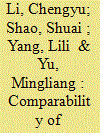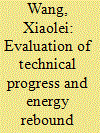|
|
|
Sort Order |
|
|
|
Items / Page
|
|
|
|
|
|
|
| Srl | Item |
| 1 |
ID:
150894


|
|
|
|
|
| Summary/Abstract |
Du and Lin (2015) argued that the estimation model of the economy-wide energy rebound effect proposed by Shao et al. (2014) should be revised and provided an alternative approach, which they considered to be more consistent with the definition of the rebound effect. However, in this comment, we do not find a valid correction or modification to our original model, because their criticism logic does not originate from the corresponding mechanism in Shao et al. (2014), and their estimation formula has a different benchmark with ours. Moreover, their data samples were also different from ours, generating the incomparable results, and there are some irrational results in the comment. Even based on different estimation formulas in the two studies and using the same estimation method and data sample, the comparison results show that the problem of the estimation formula in our previous study which they claimed does not really exist. We argue that this comment is not consistent with the principle of the rebound effect. Actually, their work can be only regarded as proposing an alternative approach for the estimate of the rebound effect. Therefore, their argument is not enough to overturn our previous study.
|
|
|
|
|
|
|
|
|
|
|
|
|
|
|
|
| 2 |
ID:
168354


|
|
|
|
|
| Summary/Abstract |
The actual energy savings from efficiency improvement may be less than expectations because of behavior response of micro-units, which is named as rebound effect. For producers, the magnitude of such response depends on the operating flexibility. However, the precise; role of operating flexibility in rebound effect is still unknown because of difficulties in measuring operating flexibility. Over the past four decades, the Chinese government has implemented a wide range of reforms aiming at market-oriented transition, which increase operating flexibility of micro-units. It is natural to be questioned whether China's market-oriented reform increases energy rebound effect. In this study, we aim to explore the impacts of marketization on rebound effect. Using partially linear functional-coefficient panel data model to avoid prior criteria in model specification and smooth the change of rebound effect across regions, we found that about 20% of originally expected energy conservation from energy efficiency improvement would be rebounded in 2013. Furthermore, the results demonstrate that in line with China's uneven reform across regions, coastal provinces such as Jiangsu, Zhejiang, Tianjin, Shanghai, Beijing, and Guangdong, have larger rebound effects, which may be connected with their larger operating flexibility. The findings can enhance our understanding on the mechanisms of rebound effect as behavior responses. We also anticipate our paper to provide knowledge and broader implications toward optimal policy designs alongside China's ongoing market-oriented reforms.
|
|
|
|
|
|
|
|
|
|
|
|
|
|
|
|
| 3 |
ID:
162282


|
|
|
|
|
| Summary/Abstract |
As a pillar industry in China, the iron & steel sector have under through rapid growth and technical progress for decades. However, energy polices aiming at energy savings may not be as good as expected due to the existence of rebound effects. The motivation of the paper is to analysis the nexus between technical progress and energy rebound effects. Based on a three-input trans-log cost function model, we first estimate the share equation and the corresponding price elasticity for each input factor. Then, the rebound effect in China's iron & steel industry over 1985–2015 is evaluated through decomposing the energy prices. Empirical results show that: (1) The price elasticities of input factors are negative; (2) Energy/capital and energy/labor show substitute relationships; (3) The average energy rebound effect in the ISI is as high as 73.88%; (4) The energy rebound effect shows a downward trend before the 11th Five-year period and then an upward trend after that. Therefore, policies proposals of lowering the rebound effect should be placed not only on technical progress, but also on energy price reform by reducing energy subsidies and thus accelerating energy price marketization, so as to promote energy substitution, reduce energy rebound effect and produce further economic and environmental benefits.
|
|
|
|
|
|
|
|
|
|
|
|
|
|
|
|
| 4 |
ID:
132615


|
|
|
|
|
| Publication |
2014.
|
| Summary/Abstract |
The energy rebound effect has been a significant issue in China, which is undergoing economic transition, since it reflects the effectiveness of energy-saving policy relying on improved energy efficiency. Based on the IPAT equation and Brookes× explanation of the rebound effect, this paper develops an alternative estimation model of the rebound effect. By using the estimation model and latent variable approach, which is achieved through a time-varying coefficient state space model, we estimate China×s economy-wide energy rebound effect over 1954-2010. The results show that the rebound effect evidently exists in China as a result of the annual average of 39.73% over 1954-2010. Before and after the implementation of China×s reform and opening-up policy in 1978, the rebound effects are 47.24% and 37.32%, with a strong fluctuation and a circuitously downward trend, respectively, indicating that a stable political environment and the development of market economy system facilitate the effectiveness of energy-saving policy. Although the energy-saving effect of improving energy efficiency has been partly realised, there remains a large energy-saving potential in China.
|
|
|
|
|
|
|
|
|
|
|
|
|
|
|
|
|
|
|
|
|